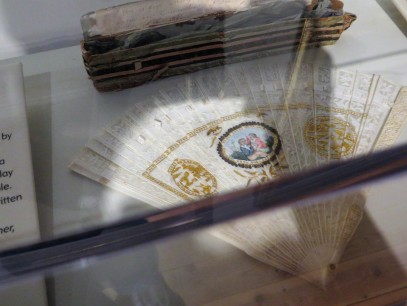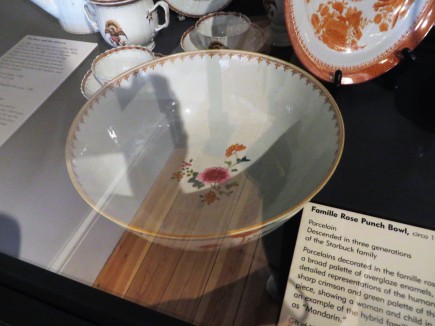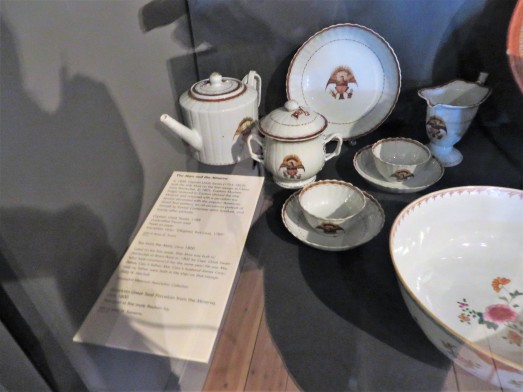A long overdue post on the rest of the Nantucket Whaling Museum.
After tearing myself away from the archive exhibit, I browsed a bit more of the museum and learned more about the whaling industry in Nantucket.
The museum had on display many of the treasures the men brought home from far flung places. They were gifted objects of cultural significance by the natives of places they visited and also purchased fine goods to be sent or carried home with them.

Chinese fan 1821, pierced ivory, painted silk
This Chinese fan, dating to 1821, was purchased by Captain Eliakim Gardner of Baltimore, Maryland, captain of the ship Orozimbo. Captain Gardner presented the fan to his wife Pamela who passed it on to her granddaughter Mary Myrick Gardner. It was passed down through the years and in 1887 the fan was given as a wedding gift to Florence Folger when she married William A. Webster. The scene on the fan depicts a European couple. The fan is also decorated with gold inlay.
Sea captains also commissioned china patterns for their wives. This pattern, famille rose, uses overglaze enamels to create detailed depictions of the human form, in this case, a woman and child. This pattern is an example of a hybrid pattern known as “Madarin.”

Famille Rose Punch Bowl c. 1755-1770
The Famille Rose punch bowl was passed down through three generations of the Starbuck family. It must have been a cherished possession.

“Fitzhugh” Dinner Service c. 1810
This blurry photo depicts the “Fitzhugh” dinner service belonging to Gideon Swain (1776-1848). His initials are featured in the medallion in the center. The pattern comes from a design originally ordered by a Thomas Fitzhugh, Captain in the East India Company in 1780. The English firm Spode later copied the pattern. The design became more elaborate as the 19th-century advanced and was popular well into the 20th-century as well.

The Mars and the Minerva
The sign accompanying this tea service tells the story of Captain Uriah Swain (1754-1810), the Nantucket captain who initiated trade between China and Nantucket in 1800. The Mars returned to Nantucket with a cargo of tea and other Chinese goods and souvenirs in exchange for sealskins. In 1801, Captain Mayhew Folger sailed to Canton in the Minerva bringing back this beautiful porcelain tea service decorated with the popular American Seal design. This design features the Federal Eagle. A better image of the design can be seen at Northeast Auctions .
There were many examples of porcelain from the China trade era including creamware jugs custom made with the ship’s flag or family name painted in the design. They were made in Liverpool, England for export.
I will return with more history of Nantucket’s whaling industry. As a preview, you can read up on the gruesome process of capturing a whale and how whales were processed before viewing my post on the end products and Nantucket’s role in producing spermaceti candles and other goods from whales and for the elite citizens involved in the whaling industry,